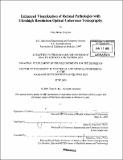Enhanced visualization of retinal pathologies with ultrahigh resolution optical coherence tomography
Author(s)
Ko, Tony Hong-Tyng, 1975-
DownloadFull printable version (31.31Mb)
Other Contributors
Harvard University--MIT Division of Health Sciences and Technology.
Advisor
James G. Fujimoto.
Terms of use
Metadata
Show full item recordAbstract
Current clinical practice calls for the development of techniques to diagnose diseases in its early stages, when treatment is most effective and significant irreversible damage can either be prevented or delayed. Optical coherence tomography (OCT) is an emerging medical diagnostic technology being investigated for applications in a number of medical fields including ophthalmology, cardiology, and gastroenterology. OCT is analogous to ultrasound except that it uses light waves rather than sound waves. OCT can achieve a much higher resolution than ultrasound in measuring the underlying tissue microstructures. Another advantage of OCT is that it can achieve imaging in a non-contact and non-invasive manner. With typical axial resolution of 10 [mu]m, OCT already provides significantly more detailed structural information than any other conventional clinical imaging technique. The development of OCT with even higher resolution would potentially have significant impact in diagnosing diseases in such fields as ophthalmology, cardiology, gastroenterology, and oncology. Ultrahigh resolution OCT systems have been developed for animal research and clinical ophthalmology. Ultrahigh resolution OCT improves the axial resolution of OCT from the standard 10 [mu]m to 1 [mu]m for animal studies and 3 [mu]m for clinical studies. This improved imaging resolution approaches that of histopathology. Therefore, OCT can potentially function as "optical biopsy" since it permits the imaging of tissue microstructure with resolutions approaching that of histopathology except that imaging can be performed in real time, without the need of tissue removal. (cont.) Using ultrahigh resolution OCT systems, animal imaging studies have been performed on mouse and rat models of retinal diseases and clinical imaging studies have been performed on more than 800 patients at the ophthalmology clinic. The results from patient imaging studies on a wide variety of retinal diseases suggest that ultrahigh resolution OCT can improve the diagnosis and management of retinal diseases as well as possibly increase the understanding of ocular disease pathogenesis. Therefore, ultrahigh resolution OCT has the potential to become an important tool in ophthalmology research and clinics.
Description
Thesis (Ph. D.)--Harvard-MIT Division of Health Sciences and Technology, 2005. Page 150 blank. Includes bibliographical references.
Date issued
2005Department
Harvard University--MIT Division of Health Sciences and TechnologyPublisher
Massachusetts Institute of Technology
Keywords
Harvard University--MIT Division of Health Sciences and Technology.